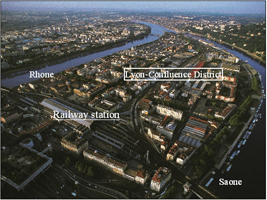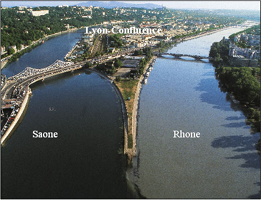 |
 |
 |
 |
 |
 |
 |
 |
 |
 |
 |
 |
Project summary
Name of the case study
Lyon Confluence Storm Water Management
Where is it located?
France
What type of activity is it?
Renovation
Short description of the case study
"Lyon Confluence" is one of Greater Lyon’s biggest projects. It is a long-term project, planned until 2030. Located between two rivers, Rhône and Saône, and long restricted to industry and transport facilities, the Perrache peninsula is undergoing a transformation. The impacts on Lyon vitality and way of life for the Greater Lyon´s inhabitants are significant. And that´s why it represents a great challenge that the city should overcome.


Lyon-confluence limits defined by 2 rivers (left) and Presentation of the project site source:"Lyon-Confluence" developer association)(right)
We propose another view of this project which was a building & land use approach: study of the whole urban renewal operation. That´s why we recommend reading the both case studies in order to tackle the project as a whole.
As far as water management is concerned, a preliminary study was done in several steps: inventory and diagnosis of existing networks, definition of objectives, definition of means, and decisions on orientations.
The diagnosis has raised some particular points to take into consideration: maintenance difficulties, existence of nuisances and troubles, and pollution of the receiving bodies. It has then been decided that proposed solutions should (definition of objectives):
-Enhance the receiving bodies quality and then protect the water resources
-Reduce the flooding risks
-Reduce operation and investment costs
-Integrate storm water management in cityscape.
The means and orientations that have then been established advocate technical solutions that:
-Build a separate sewer system only in new zones
-treat the storm water as close to the source as possible
-develop simple projects easy-to-understand for citizens
-propose a sewer network with high slope value and without pumping station.
At this stage, 13 solutions have been defined by the design section of the Greater Lyon water department. In order to evaluate and compare them in regard with sustainability, a grid has been developed by the project engineer. The assessed criteria are social, environmental, economical and governance ones (limitation of waste production, limitation of investment cost, reduction of work hardness…). Nevertheless due to time and human resources needed, the grid had no significant impact on the decision making process. It is hoped that in the future the grid might be developed and used on other cases.
This case was chosen because "Lyon-Confluence" is a large renewal project of an old industrial district into a downtown one. Due to its central position, the project has grown up in a particular political context where general stakes were highly important for Lyon influence, and where political forces have already shown their interest in sustainability.
The first approach of this project was a building & land use one: the entry point was the study of the whole neighbourhood rehabilitation (see case study "Lyon Confluence major urban development"). And then it appears that the combination of a sector specific case study (concerning water management) combined with a building & land use one was relevant. That´s why we recommend reading the both case studies in order to have a whole vision of the project: this one and the water management one. The opportunity to propose this vision has leaded us to choose this project as a case study.
This case study is related with the water key-problem "Management and conception of urban water infrastructures".
What tools were used to assess sustainability?
More information